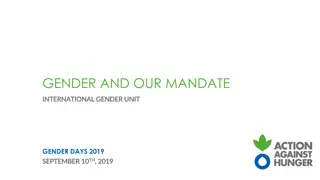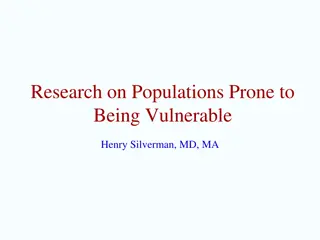Gender and Diversity Analysis in Vulnerability and Capacity Assessment (VCA)
Gender and diversity play crucial roles in assessing vulnerabilities and capacities within communities for effective disaster response. This analysis ensures inclusive understanding of risks, needs, and marginalized groups, enabling appropriate responses. It highlights the importance of examining relationships, constraints, and distinct realities faced by different individuals and groups.
Download Presentation

Please find below an Image/Link to download the presentation.
The content on the website is provided AS IS for your information and personal use only. It may not be sold, licensed, or shared on other websites without obtaining consent from the author. Download presentation by click this link. If you encounter any issues during the download, it is possible that the publisher has removed the file from their server.
E N D
Presentation Transcript
Gender and Gender and Diversity Diversity Applying a gender and diversity analysis to VCA Introduction to Resilience Training Thai Red Cross 9-12 November 2015 www.ifrc.org www.ifrc.org Saving lives, changing minds. Saving lives, changing minds.
What we now know. Gender and Diversity Disasters can impact anyone but not everyone will be affected in the same way Even during non disaster periods, not everyone experiences daily life in the same way .people with disabilities, the elderly, men, women boys and girls all have different needs, during and after an emergency. www.ifrc.org www.ifrc.org Saving lives, changing minds. Saving lives, changing minds.
What we now know Gender and Diversity VCA (Vulnerability and Capacity Assessment) is a method of investigation into the risks that people face, their vulnerability to those risks and their capacity to cope with and recover from disasters. We know that roles and expectations attributed to people because of aspects of their gender or diversity can lead to people being more vulnerable or margenalised within society. Vulnerabilities (physical, social, economic, or environmental) can become even more prevalent in times of disasters. www.ifrc.org www.ifrc.org Saving lives, changing minds. Saving lives, changing minds.
Gender and Diversity Therefore it is important that we understand what these vulnerabilities are for each group When we do a VCA it must be informed by a gender analysis. This ensures that we are inclusive and understand the risks, capacities and vulnerabilities of the whole community. www.ifrc.org www.ifrc.org Saving lives, changing minds. Saving lives, changing minds.
Gender & Diversity Analysis within VCAs and assessments Gender analysis examines relationships between females and males; their roles, responsibilities, access to and control of resources and constraints they face relative to each other. Diversity analysis examines the distinct reality of being a particular age/age group, disabled and other contextual factors (e.g. minority group, ethnicity, etc.)
Why is a gender and diversity analysis essential? Gender and Diversity A gender and diversity analysis within a VCA: Ensures that we know who is affected: e.g. women, men, boys, girls, older people, people with disabilities, pregnant women, ethnic minority groups, migrants, women who have survived sexual violence, Ensures that we know how they are affected and Ensures we understand the needs, capacities and vulnerabilities of these individuals and groups so we can respond appropriately. www.ifrc.org www.ifrc.org Saving lives, changing minds. Saving lives, changing minds.
Some considerations when conducting a gender and diversity analysis Gender and Diversity What is the profile of the affected group? (i.e. number of households and household members disaggregated by sex and age; number of single male and female heads of household; number of pregnant and lactating women; and number (male/female) of unaccompanied children, older people, persons with disabilities, chronically ill, etc.) Are there any other potentially vulnerable groups in the population such as ethnic minority groups, migrants, class or caste groups for example Sex- and age-disaggregated data (SADD) data broken out by sex and age (or age group) www.ifrc.org www.ifrc.org Saving lives, changing minds. Saving lives, changing minds.
Some considerations when conducting a gender analysis Gender and Diversity Are assessment teams gender-balanced? Are specific actions required to create permission and space for women and marginalised groups to participate in assessment teams? If so, what are these? Are there mechanisms in place to ensure participant groups are representative and participatory. If there are social or cultural restrictions that prevent women from participating, are these being addressed? Have males and females of all ages, including those from marginalised groups, been consulted and involved in assessments to determine their specific needs, priorities and concerns related to dignity, access, participation and safety? www.ifrc.org www.ifrc.org Saving lives, changing minds. Saving lives, changing minds.
Considerations when conducting a gender and diversity analysis Gender and Diversity Understanding the daily routine of men and women, boys and girls; both for DRR plans but also for participation in VCAs Understanding household/community? who are the key in the decision makers What are the expected roles and responsibilities of males and females in the household and in the community for each sector e.g. division of labor/control of resources? Maintenance of water points, latrines and bathing areas, in the collection of water and fuel?) www.ifrc.org www.ifrc.org Saving lives, changing minds. Saving lives, changing minds.
Considerations when conducting a gender analysis Gender and Diversity Never make assumptions, use a gender analysis to inform your understanding of a context, community and situation Once you have conducted your gender analysis Information must always be used to inform programme planning, monitoring and evaluation! www.ifrc.org www.ifrc.org Saving lives, changing minds. Saving lives, changing minds.
VCA tools used by Thai Red Cross Gender and Diversity Structured and semi-structured interviews; Focus group discussion; Direct observation Hazard mapping (perception) Vulnerability mapping Daily schedules times of the day Capacity/resource mapping; Transect walk; Seasonal calendar; Historical profile (elderly); Livelihood analysis Institutional and social network analysis www.ifrc.org www.ifrc.org Saving lives, changing minds. Saving lives, changing minds.
Focus group discussions Gender and Diversity www.ifrc.org www.ifrc.org Saving lives, changing minds. Saving lives, changing minds.
Resource mapping Gender and Diversity www.ifrc.org www.ifrc.org Saving lives, changing minds. Saving lives, changing minds.
Gender and Diversity www.ifrc.org www.ifrc.org Saving lives, changing minds. Saving lives, changing minds.
Gender and Diversity www.ifrc.org www.ifrc.org Saving lives, changing minds. Saving lives, changing minds.
Daily schedule Gender and Diversity www.ifrc.org www.ifrc.org Saving lives, changing minds. Saving lives, changing minds.
Price of not including a gender and diversity analysis We may not get all the information we need to reduce the risks of disasters for everyone in a community We limit the effectiveness of our DRR or CBDRR programmes Our programmes will not reach the most vulnerable We may unintentionally cause greater harm to certain groups in a community by not understanding their vulnerability and capacities and the relationships with other members of the community.
Thank you! Gender and Diversity Any questions? www.ifrc.org www.ifrc.org Saving lives, changing minds. Saving lives, changing minds.
FOR FURTHER INFORMATION ON GENDER AND DIVERSITY PLEASE CONTACT: IFRC GENDER AND DIVERSITY OFFICER, SOUTH EAST ASIA REGIONAL DELEGATION CHRISTINAHANEEF (christina.haneef@ifrc.org) THIS PRESENTATION IS PUBLISHED BY INTERNATIONAL FEDERATION OF RED CROSS AND RED CRESCENT SOCIETIES P.O. BOX 372 CH-1211 GENEVA 19 SWITZERLAND TEL.: +41 22 730 42 22 FAX.: +41 22 733 03 95































